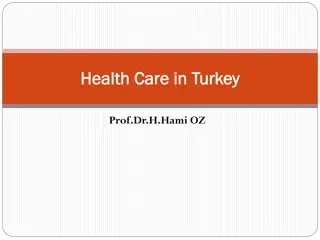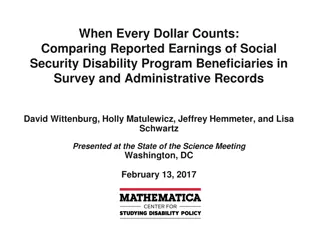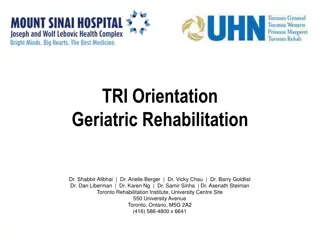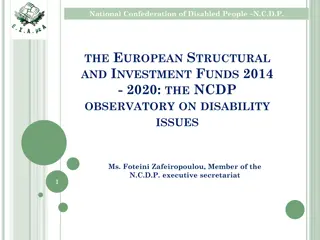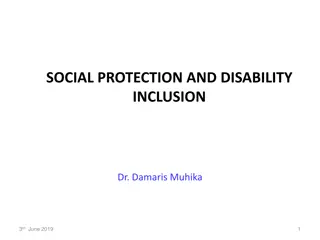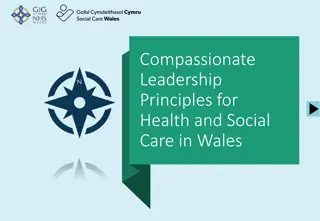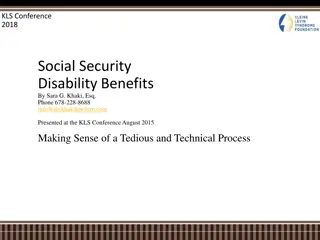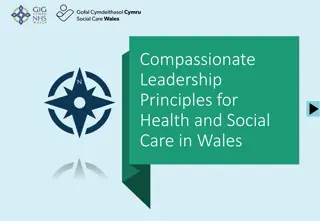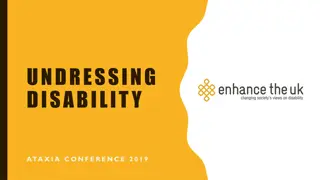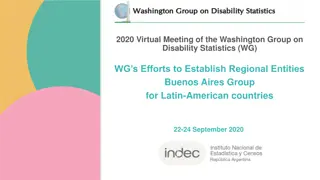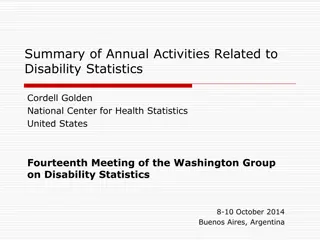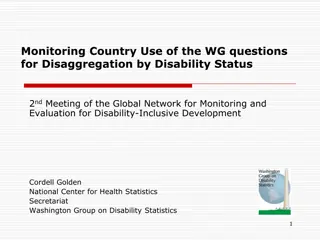Understanding Social Security Disability Programs and Compassionate Allowances
SSA administers two disability programs - SSDI and SSI - under the Social Security Act. To qualify as disabled, you must be unable to work, have a lasting medical condition, and can't do age-appropriate activities for children. There are ways to apply for benefits online, through Social Security offices, or by phone.
Download Presentation

Please find below an Image/Link to download the presentation.
The content on the website is provided AS IS for your information and personal use only. It may not be sold, licensed, or shared on other websites without obtaining consent from the author. Download presentation by click this link. If you encounter any issues during the download, it is possible that the publisher has removed the file from their server.
E N D
Presentation Transcript
Social Security Disability Programs and Compassionate Allowances Social Security Disability Programs and Compassionate Allowances
SSA administers two disability programs under the Social Security Act: Social Security Disability Insurance (SSDI) (financed with Social Security taxes paid by workers, employers via your FICA taxes) Supplemental Security Income (SSI) (needs-based program)
We consider you disabled under Social Security rules if: You cannot do work that you did before We decide that you cannot adjust to other work because of your medical condition(s); and Your disability has lasted or is expected to last for at least one year or to result in death SSA does not pay partial or short-term disability benefits
In the case of children under the age of 18, applying for Supplemental Security Income (SSI) Medically determinable impairment that causes functional limitations The limitations must severely reduce the child s ability for age appropriate activities The impairment must have lasted or be expected to last for a continuous period of at least 12 months or be expected to result in death
Since 2008, we have approved more than 500,000 claims through the CAL process
Manual Processes: Presumptive Disability (1974) Terminal Illness (1991) Automated Processes: Wounded Warriors (2005) Quick Disability Determinations (QDD) (2008) Compassionate Allowances (CAL) (2008)
There are several ways to apply for benefits: Visit our website at www.socialsecurity.gov to apply online Call or visit any Social Security office to schedule an appointment Contact us toll-free at 1-800-772-1213 (TTY 1-800-325-0778)
We ask you to: tell us about your condition the treatment you ve received for your condition any medications that you are taking your educational background past work history provide us permission to request medical records from your doctors
Application forwarded to the State Disability Determination (DDS) agency DDS contacts your medical sources DDS reviews your statement of your daily activities You may need to attend a consultative examination DDS makes a disability decision on your claim
Is there substantial gainful activity? Is the impairment severe? Does the impairment meet or equal a medical listing? Can the claimant perform any of their past relevant work? Can the claimant perform any other type of work? 1. 2. 3. 4. 5.
1. Is there substantial gainful activity? 2. Does the child have a medically determinable impairment (s) that is severe? 3. Does the impairment(s) meet, medically equal, or functionally equal the medical listings?
Goal-- Quickly identify conditions that invariably meet Social Security disability standards CAL moves individuals to the head of the line for a disability decision It is not a separate program from the SSDI and SSI programs Initiative began with public outreach hearing in 2007 50 conditions selected for initial rollout (October 27, 2008) 100 conditions as of July 30, 2011 200 conditions as of December 6, 2012 228 conditions as of September 16, 2017
Potential CAL conditions are identified primarily from Public outreach hearings Advocacy groups Social Security and Disability Determination Service communities Counsel of medical and scientific experts research with the National Institutes of Health (NIH)
Relationships with many advocacy groups including the: American Cancer Society Adult Congenital Heart Association ALS Association Alzheimer s Association American Heart Association Inflammatory Breast Cancer Foundation Myotonic Dystrophy Foundation National Multiple Sclerosis Society National Organization for Rare Disorders
Claimant applies alleging a CAL condition The impairment summaries are available to adjudicators at all levels (initial appeals) Search and find software identifies CAL condition CALS may be manually added/removed at all adjudicative levels Case gets a CAL indicator alerting adjudicator that a case need to be fast-tracked We apply the same standard of disability to all claims, including claims identified for the CAL process. Adjudicator has the option to click on hyperlink to an impairment summary Impairment summaries guide adjudicators in evaluation of evidence and policy application
Added Congenital Myotonic Dystrophy to the CAL list on September 16, 2017 Impairment Summary Available to Adjudicators for Making a Quicker Disability Determination Majority of the CAL Congenital Myotonic Dystrophy cases are allowances
CONGENITAL MYOTONIC DYSTROPHY Steinert s Disease ALTERNATE NAMES Myotonic dystrophy is a rare, inherited neurological disorder caused by a mutation of the DMPK gene. The disease is characterized by the repeating CTG nucleotide bases in DNA. Congenital symptoms apparent after birth.These can include severe muscle weakness resulting in respiratory insufficiency, dysphagia leading to aspiration pneumonia, cardiomyopathy, and failure to thrive. Developmental delays are common. Later complications may include excessive daytime sleepiness, intellectual disability, autism, and ADHD. If the child survives to adulthood, he/she will start to take on the symptoms commonly seen in adult myotonic dystrophy type 1 as well. Congenital Myotonic Myotonic Dystrophy Dystrophy (type 1) is the most severe form, with signs and DESCRIPTION Diagnostic testing there can be multiple causes of weakness and hypotonia in newborns. The diagnosis can be confirmed through molecular genetic testing. Other means of diagnosis are electromyography (EMG), muscle biopsy, and sometimes-elevated serum CK concentration. Physical findings the face and throat muscles, dyspnea, dysphagia, ineffective nursing due to weak suck, slurred speech, extremity contractures, and developmental delays. https://secure.ssa.gov/apps10/poms.nsf/lnx/0423022143 I Diagnostic testing: Congenital myotonic dystrophy is difficult to recognize because DIAGNOSTIC TESTING, PHYSICAL FINDINGS, AND ICD-9-CM CODING Physical findings: Physical examination shows general muscle weakness, especially of https://secure.ssa.gov/apps10/poms.nsf/lnx/0423022143
CAL initiative is not a separate program from SSAs two disability programs, SSDI and SSI There is no additional money above what an individual is eligible for under the Social Security Disability Insurance (SSDI) and/or the Supplemental Security Income disability programs SSA will expedite the applications of those with a CAL condition
General Social Security www.ssa.gov Application Information www. ssa.gov/planners/disability/apply.html Compassionate Allowances www.ssa.gov/compassionateallowances/
Overview of Disability Benefits- PDF https://www.ssa.gov/pubs/EN-05-10029.pdf Publication List https://www.ssa.gov/pubs/?topic=Disability Overview of Disability Benefits- Website https://www.ssa.gov/benefits/disability/ Benefits for Children with Disabilities https://www.ssa.gov/pubs/EN-05-10026.pdf




